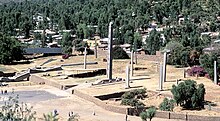King Ezana's Stele
History

This monument, properly termed a stele (hawilt or hawilti in the local Afroasiatic languages) was carved and erected in the 4th century by subjects of the Kingdom of Aksum, an ancient civilization focussed in the Ethiopian and Eritrean highlands. The stelae are thought to be "markers" for underground burial chambers. The largest grave markers were for royal burial chambers and were decorated with multi-story false windows and false doors; nobility would have smaller, less decorated stelae. King Ezana's Stele is likely to be the last example of this practice, which was abandoned after the Axumites adopted Christianity under King Ezana. Ezana was the first monarch of Axum to embrace the faith, following the teachings and examples of his childhood tutor, Frumentius. King Ezana's Stele is also the only one of the three major "royal" obelisks (the others being the Great Stele and the Obelisk of Axum) that was never broken.
In 2007–2008, during the reassembly of the Obelisk of Axum, which had been taken to Italy in 1937 and returned to Ethiopia in 2005, King Ezana's Stela was structurally consolidated by a team of engineers led by Giorgio Croci, Professor of Structural Problems of Monuments and Historical Buildings at Sapienza University of Rome.
See also
References
- ^ "Aksumite Stelae - Museum of Archaeology & Ethnology - Simon Fraser University". www.sfu.ca. Retrieved 2022-04-10.
- ^ Obelisk arrives back in Ethiopia BBC website, originally published 19 April 2005
- Sienkewicz, Thomas J. (2002). Encyclopedia of the Ancient World. ISBN 9780893560386. Retrieved 27 September 2014.